I consider it an honor and privilege to teach the Constitution in my 5th grade classroom. My social studies class is usually the very first exposure that my students have to our most valuable government document.
In my classroom, I divide the Constitution into three parts to help with organization. The three parts are the Preamble, Branches of Government, and the Bill of Rights. There are other parts to the Constitution, however, these three sections cover my curriculum standards well.
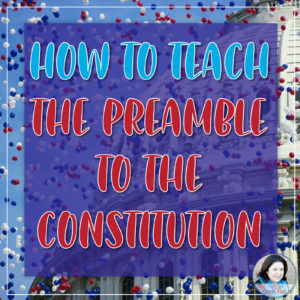
The Preamble to the Constitution explains why this document was written and the hopes that our founding fathers had for a brand new nation. This powerful piece of literature means absolutely nothing to students if they don’t understand the words. So, the first thing I do is break down the Preamble, word by word, for students. Our interactive notebooks provide a fabulous place to write this sort of thing.
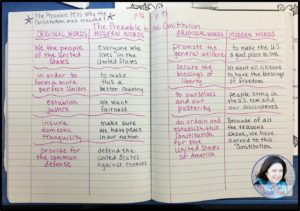

After writing out the meaning of each part of the Preamble, I read the following book to students. This book is “cartoon-ey” but it is a non-threatening way to explore the Preamble. Each page features one piece of the Preamble in which the characters are acting out what that phrase means. So, after reading each page, we discuss the illustration, what the characters are doing, and how this part of the Preamble affects our daily lives as Americans.
* Please note that Thrive in Grade Five (Jenifer Bazzit) is a participant in the Amazon Services LLC Associates Program, an affiliate advertising program designed to provide a means for sites to earn advertising fees by advertising and linking to amazon.com. *
Once students have a firm grasp on the parts of the Preamble, I play the School House Rock video, “The Preamble.” Click the link to see the 4 minute video on YouTube. I usually play this video once per day for a week and guess what?? The kids memorize the Preamble in that time. It’s so much easier to memorize things when they are set to music!
I really do think it’s important for students to memorize the Preamble to the Constitution. So, I created the Great Preamble Race. Students recite the Preamble to family members, teachers, and other adults. In exchange, the adults sign spaces on their game boards until the student reaches the finish line. It’s really fun and creates an interest in the Preamble among my often-reluctant 5th graders. Download the Great Preamble Race for FREE from my TPT store by clicking this image:
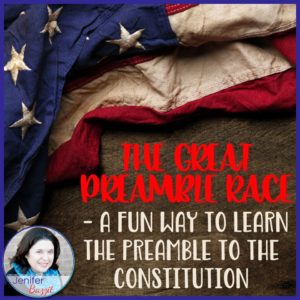
Finally, I like for my students to work cooperatively whenever possible. So, I write the following blank template on chart paper and ask my students to work cooperatively to illustrate the parts of the Preamble to the Constitution.
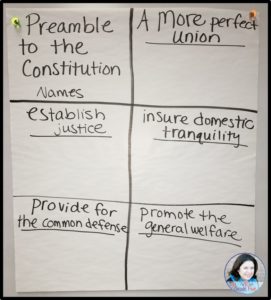

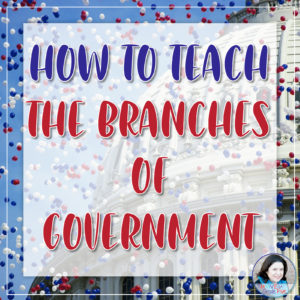
What has three parts…is fun to teach…but can be really confusing for students?!? It’s the three branches of government!! Honestly, I love teaching the three branches but when trying to help students understand how the branches work together, it can get a bit confusing. So, we leave the concepts of checks and balances and separation of powers for last.
I definitely take a little extra time when teaching the Branches of Government because it’s essential that we make the Constitution accessible for our students.
Before I begin my lessons on the Branches of Government, I present the following question to students. I ask them to discuss their answers in small groups. Then, I ask each student to write one paragraph to answer the question.

You can imagine the answers students come up with. I rarely ever have a student, when first presented with this question, say, “the people.” It’s ok that they are so confused about this question because it gets them thinking about where the government gets its power. At this point, I explain the term “Consent of the governed,” in detail. We talk about what each word means and about how the government would not be able to function UNLESS the people allowed it to function.
Once students understand that it’s all of us, as Americans, who give the government its power, we move into a discussion of each branch of government separately.
Legislative Branch
This branch is headed by Congress. Their primary job is to make laws for our nation, however, Congress also has many other responsibilities. We discuss the founding fathers’ conflicts and compromises surrounding representation, including the New Jersey Plan, Virginia Plan, Great Compromise, and Three-Fifths Compromise.
Judicial Branch
This branch is headed by the Supreme Court. The Supreme Court is the highest court in our land and their decisions are the final word. The Supreme Court has many responsibilities, including cancelling laws that do not follow the Constitution.
In our political climate today, it’s been interesting to talk about some of the latest decisions of the Supreme Court and how these decisions have shown the power of the Court over the other two branches of government.
Executive Branch
This branch is headed by the President. The main job of the people serving in this branch is to enforce the laws of the United States. However, there are many other responsibilities also assigned to the Executive Branch.
If I’m being honest, this branch of government has been reaaaaalllyyyy hard to teach for the past couple of years. I leave my politics out of the classroom but my students do not. They come to school with the knowledge of what their parents say and they use that as their opinion base. I have to work really hard to get students to think for themselves and decide what they believe is right.
With that being said, it is amazing to watch history unfolding right now and be able to use what is happening in our country to highlight the responsibilities and interactions of the Branches of Government!
Assignment
Ask students to find a newspaper article or internet article that discusses an action by one of the Branches of Government and bring it to class. This is a great way to open students’ eyes to the Branches of Government at work!
Checks and Balances / Separation of Powers
I know that these two concepts are different but I teach them at roughly the same time. You could spend an entire year talking about the intricacies of these concepts with adults but, hey, my students are 5th graders. I want them to have the idea and move on. I use the following chart to illustrate the interactions among the branches of government.
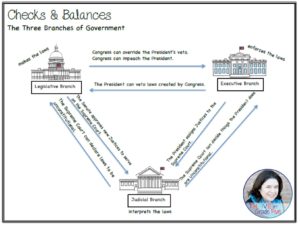
One cannot teach the branches of government without School House Rock, just sayin’!! This short music video dives into the jobs of each branch, separation of powers, and checks and balances. I show it every day for about three days. View the video here on YouTube: THREE RING GOVERNMENT
To reinforce checks and balances, I create this large poster on butcher paper. I ask students to write one power that one branch has over another branch. Examples of what students write: “The President can veto bills made by Congress.” and “The Supreme Court cancels laws that do not follow the Constitution.” Be sure to make your poster large enough to allow all of your students to write on it.
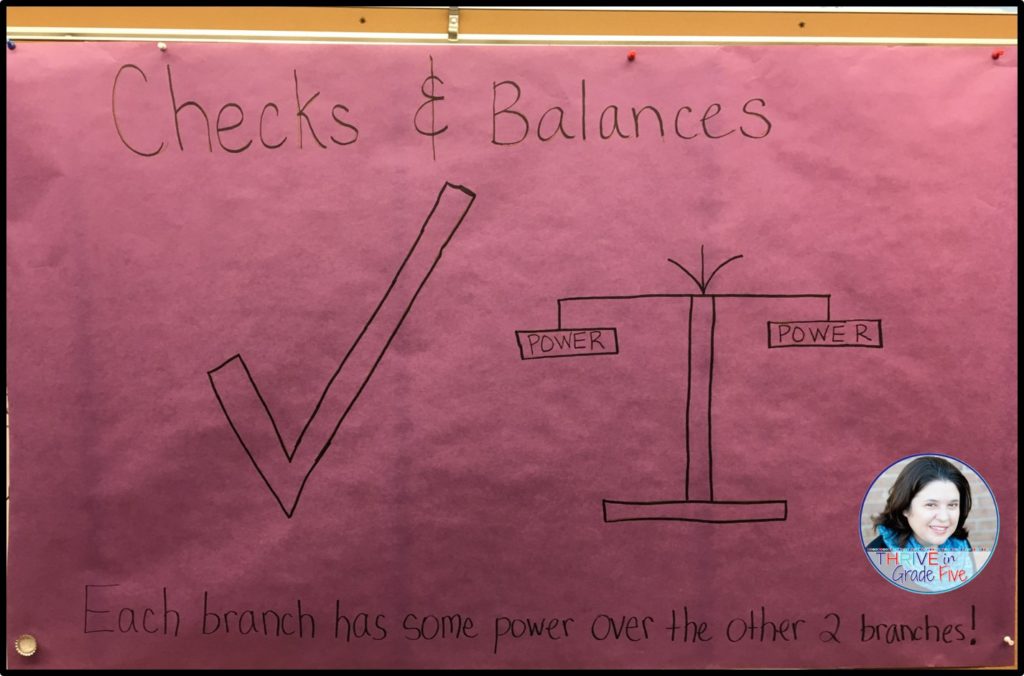
Another (really fun) thing that I do is to ask students to write a letter to the head of ONE branch of government. They may choose to write a letter to the President, the Supreme Court, or their Senator/Representative. I ask them to write a letter addressing their concerns and telling what they’ve learned about the responsibilities of each particular branch. Many times, my students actually receive letters back and they are soooooo excited to show everyone! Just in case you need addresses:
President of the United States
The White House
1600 Pennsylvania Ave NW
Washington, DC 20500
Supreme Court of the United States
1 First Street, NE
Washington, DC 20543
Representatives/Senators vary by state, so be sure to look up those addresses.
Finally, I show students pictures of the White House, Supreme Court, and the U.S. Capitol building. I ask them to compare/contrast the architecture of the buildings and tell how the outside of each building gives a clue as to what goes on inside the building.

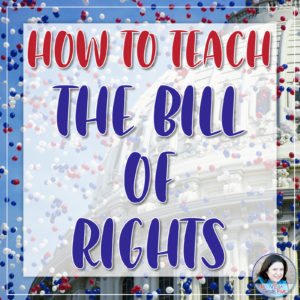
I will admit it! The Bill of Rights is my favorite part of the Constitution to teach! Teaching about our rights as Americans leads to some amazing, spirited discussions.
It’s vital, in my opinion, to help students relate the Bill of Rights to their everyday lives.
The very first thing that I do is introduce students to the 10 Amendments that make up the Bill of Rights. I am very careful to point out that the addition of the Bill of Rights protects individual freedoms and liberties. In fact, some of the states absolutely refused to ratify the Constitution until individual freedoms were addressed and protected.
I lead students in writing the following explanations into their notebooks:
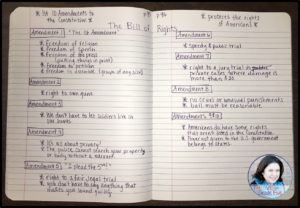
You may notice that I have not included the original English on these notebook pages. I do a lot of primary source work with my students and I do make sure that they are familiar with 18th Century English. However, when talking about the Bill of Rights, I want them to know exactly what their rights are and worry about the primary source language later.
If you scroll to the very bottom of this blog post, you will be able to have my Bill of Rights in Modern Language pdf emailed to you for free!
Once students are familiar with their rights, we discuss scenarios in which a particular person’s rights may or may not have been respected. Once example scenario I use with my students:
George is planning to meet six of his friends for their weekly walk at the park. Earlier in the day, a robbery occurred at a gas station across town. The police are looking for the robbery suspect but are having no luck. While walking to the park, George is stopped by Officer Mathis. The officer asks George to empty his pockets and show him the inside of his backpack. George refuses to show the officer any of his personal property without a warrant from a judge. Does George have the right to refuse the officer?
This scenario and the others that I use in my classroom spark lively discussions about personal rights and public safety. I always bring students back to the Bill of Rights and we decide whether or not each individual had their rights respected or not.
Once students are very familiar with the Bill of Rights, I ask each of them to choose one right to research. They are to read about it in books, on the internet, ask adults about their experiences, etc. Then, they write a single page report for me. I also ask students to discuss what they learned for about one minute in front of the class.
No joke, I had a young lady a few years back who spoke about the “Right to Bear Arms.” She passionately described the different types of animals that her dad hunted and where he kept the skins of the animals he brought home. The other students either didn’t notice or they were too gracious to burst out laughing… I don’t know which one it was. After that, I knew that I needed to be MUCH more clear on what it means to “bear arms.”

As a classroom acknowledgment of our rights, I make a large butcher paper chart for the hallway. In the middle, I write “We Value Our Rights.” I ask students to write one right that means the most to them (it’s really hard to choose) and sign their names.

If you’d like to bring the Constitution to life in your classroom, I have just the resource for you! Click on the image below to view my favorite resource for teaching the Constitution:
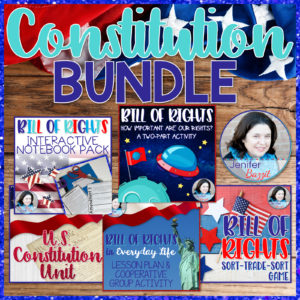
I have a free resource for you! Please enter your name and email address to receive my Constitution Practice Pages freebie. These pages are engaging and purposeful!
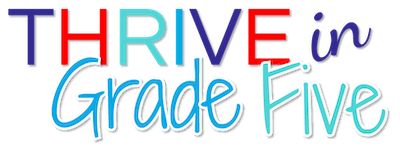


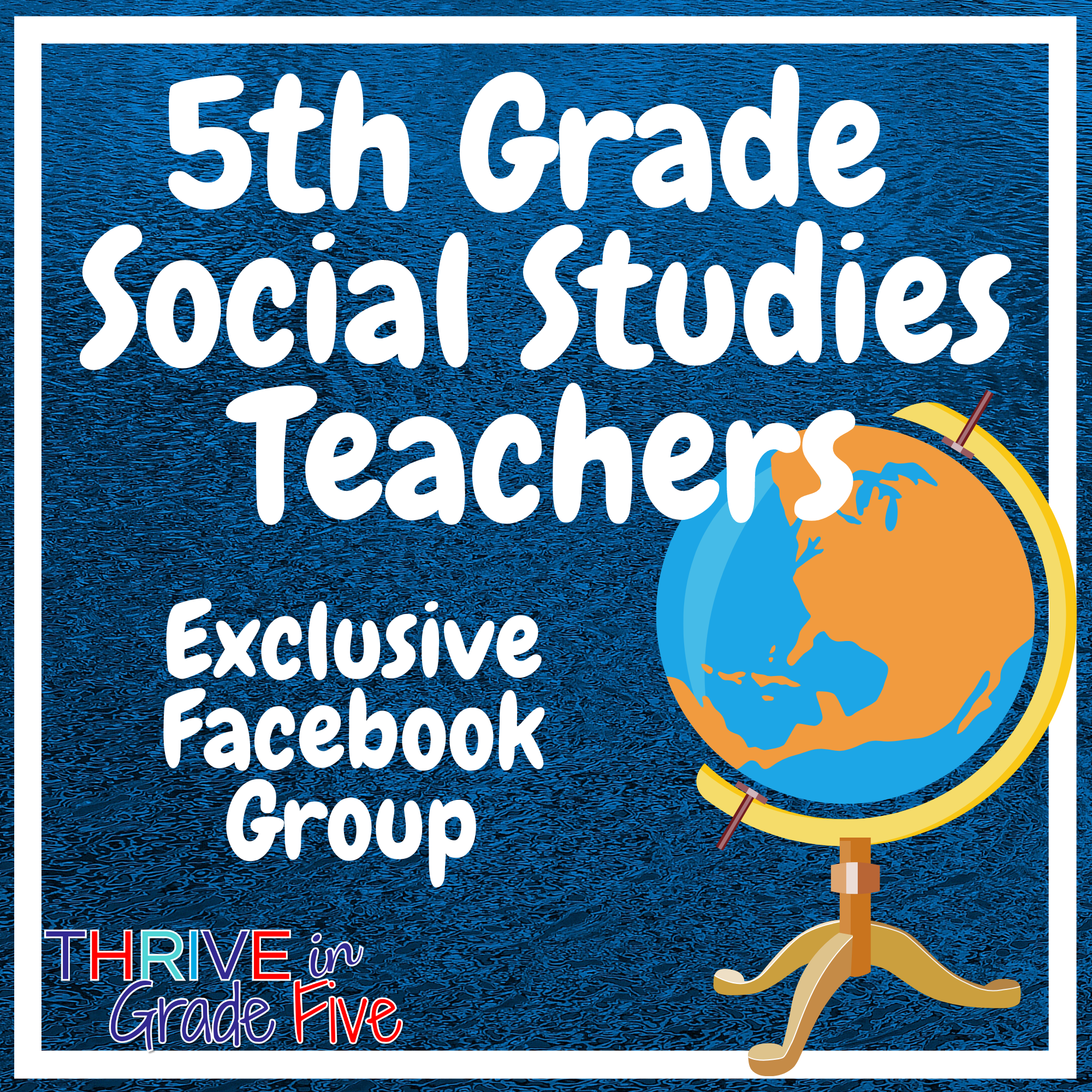

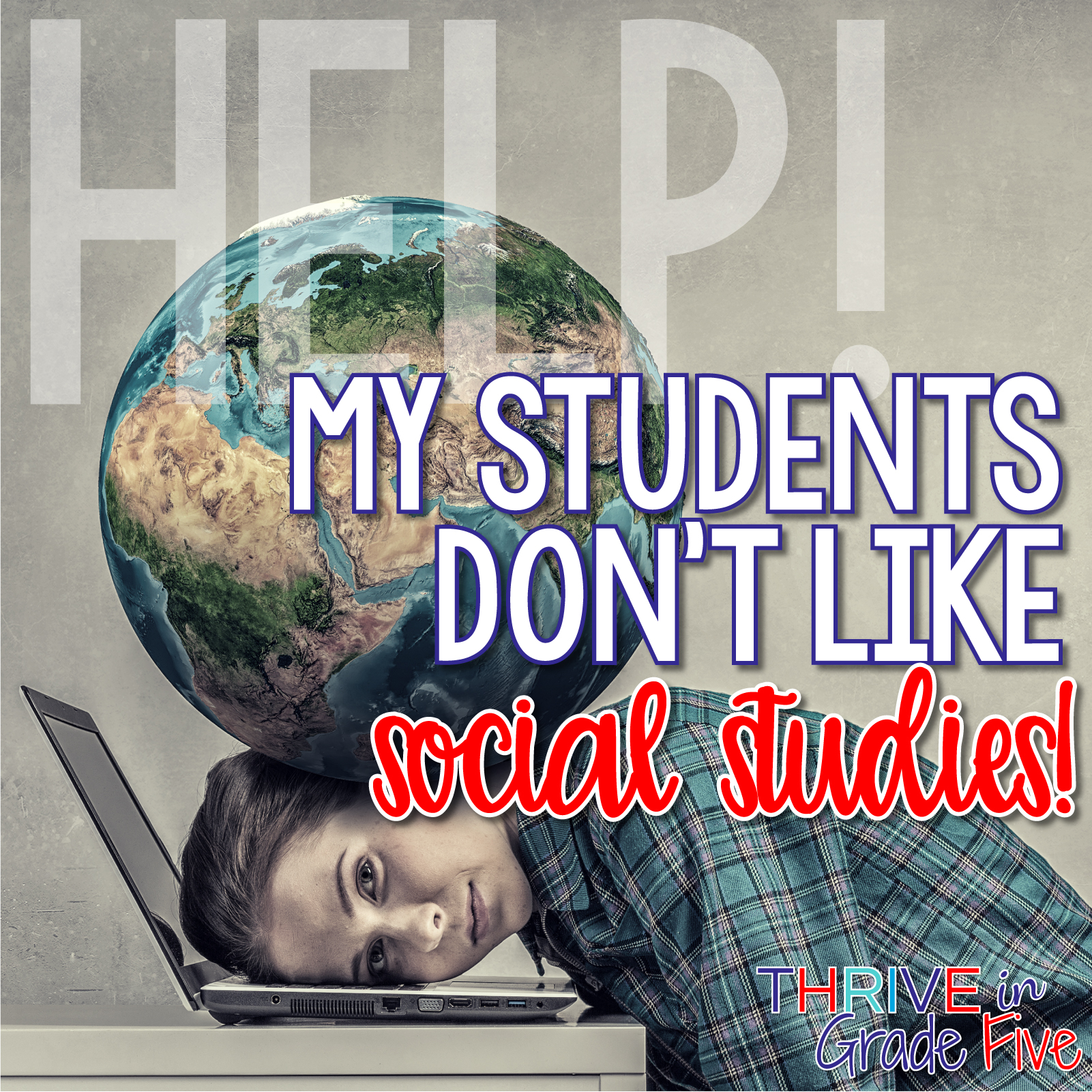

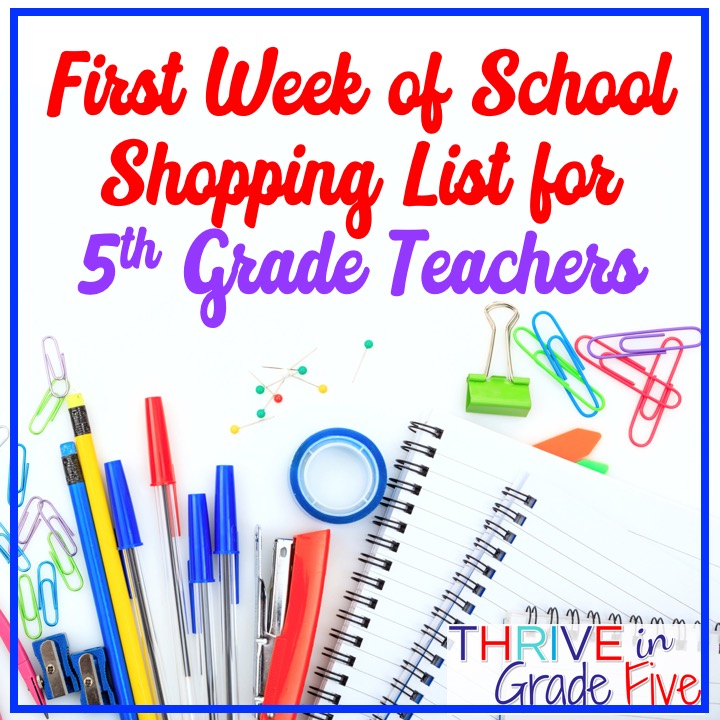
15 Comments
This is awesome! As a first year teacher I need all the help I can get!
Jenifer,
I just wanted to let me know how impressed I am with your social studies blog. I am a homeschooling mom (new to this role) and my daughter and I are both getting so much out of your Constitution and Bill of Rights teaching ideas. Even thought they are written for a traditional classroom setting, they are easily adaptable to homeschoolers.
Thank you, Stephanie! I appreciate that so much!
This is awesome. I will also be buying some of your things on TPT. Thanks.
Thank you so much, Vicky!
Thank you very much for sharing your lesson. it is wonderful. I look forward to sharing it with my students.
Sandy
I’m so glad to hear that, Sandra! Enjoy!
I have loved using your blog as a guide and your products for my kiddos! I was wondering if you teach about the Constitutional Convention and Anti/Federalists at the end of the unit or at the beginning?
Hi Elsa! Thanks for reaching out to me. I teach those at the beginning of my Constitution unit!
I have just stumbled across your blog and LOVE it. I really enjoy your activities and how you use hands-on learning to teach such important parts of our history. I have booked marked your site and will be a frequent visitor. I am using your lessons on teaching the Declaration of Independence as well as the Preamble to the Constitution. Thank you!
I am so glad to hear this, Stephanie! Thank you for taking the time to leave a comment 🙂
I can’t find the PDF of the Bill of Rights in kid friendly language. Can I get that from you? Your site is awesome!
Sure, Ann! Please email me at jenifer@thriveingradefive.com